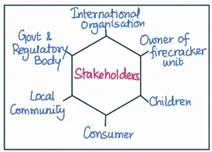Answer:
| Approach:
Introduction
- Shortly analyze the case study.
Body
- Ethical issues involved in the case
- Reaction after the visit
Conclusion
|
Introduction:
The case study highlights the unethical use of child labor in the firecracker industry and the deceptive practices employed to evade legal norms. It calls for immediate action to protect the rights and well-being of children and strengthen enforcement of labor laws in the industry.

Body:
(a) Ethical issues involved in the case:
- Child exploitation: The use of child labor in the firecracker industry is a clear violation of ethical principles. It exposes children to hazardous working conditions, deprives them of education and a normal childhood, and compromises their physical and mental well-being.
- Deceptive practices: The misrepresentation of non-registered units as household-based works to evade child labor norms is unethical. It shows a lack of integrity and honesty on the part of the owner, who is deliberately trying to deceive authorities and stakeholders.
- Lack of accountability: The owner’s inability to establish a satisfactory relationship with the children raises concerns about accountability. It suggests that the owner may be exploiting children from outside the family, disregarding legal requirements and the welfare of the children involved.
- Violation of international standards: The disparity between international labor standards set by the International Labour Organization (ILO) and India’s minimum age for employment in hazardous industries creates an ethical dilemma. India’s lower age limit may be seen as compromising the rights and well-being of children compared to international norms.
(b) Reaction after the visit:
- Gather evidence: Collect comprehensive evidence, including photographs, testimonies, and any available documentation, to substantiate the findings of child labor and deceptive practices in the unit.
- Report to authorities: Report the case to the appropriate authorities, such as the labor department, child welfare agencies, or local law enforcement, providing them with the gathered evidence. Cooperation with authorities is crucial to ensure legal action against the owner and the protection of the children involved.
- Support for affected children: Advocate for the immediate removal of children from hazardous working conditions and provide them with necessary support, including access to education, healthcare, and rehabilitation programs.
- Strengthen enforcement: Call for stricter enforcement of child labor laws and regulations in the firecracker industry, emphasizing the need for regular inspections, penalties for violators, and improved monitoring mechanisms.
- Raise awareness and promote ethical practices: Engage in awareness campaigns targeting both the local community and the industry stakeholders to highlight the ethical concerns of child labor and promote ethical practices. Encourage businesses to adopt responsible sourcing policies and discourage the demand for products made with child labor.
- Collaborative efforts: Collaborate with NGOs, community organizations, and other stakeholders to develop long-term solutions to address the root causes of child labor in the area. This may involve initiatives to improve access to education, vocational training, and alternative livelihood opportunities for families involved in the firecracker industry.
Conclusion:
By taking these actions, a comprehensive approach can be adopted to address the ethical issues, protect the rights of children, and work towards eliminating child labor in the firecracker industry.
